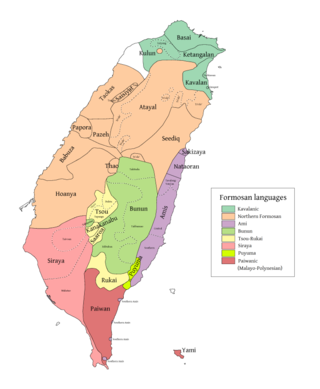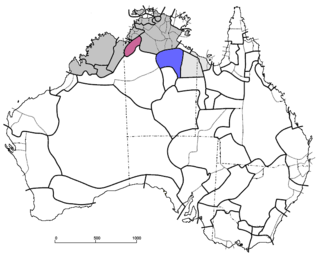Related Research Articles
In linguistics, a noun class is a particular category of nouns. A noun may belong to a given class because of the characteristic features of its referent, such as gender, animacy, shape, but such designations are often clearly conventional. Some authors use the term "grammatical gender" as a synonym of "noun class", but others consider these different concepts. Noun classes should not be confused with noun classifiers.
The Kaska language is an endangered Athabaskan language. Traditionally, Kaska was an oral aboriginal language used by the Kaska Dena people. The Kaska Dene region consists of a small area in the Southwestern part of the Northwest Territories, the Southeastern part of Yukon Territory, and the Northern part of British Columbia. The communities that are in the Kaska Dene region are Fort Ware in N.W.T.; Ross River and Watson Lake in Y.T.; Dease Lake, Good Hope Lake, Lower Post, Fireside, and Muncho Lake in B.C. Kaska is made up of eight dialects, all of which have similar pronunciations and expressional terms. The town of Watson Lake was established around the period of the second World War when the Alaska Highway was built in 1942. A major consequence of colonization was Kaska language loss. Another major cause of Kaska language loss in Canada was due to the Canadian Residential School System. The effect that these schools had on the Kaska language have caused a language gap between two generations, resulting in few young speakers.

The Bunun language is spoken by the Bunun people of Taiwan. It is one of the Formosan languages, a geographic group of Austronesian languages, and is subdivided in five dialects: Isbukun, Takbunuaz, Takivatan, Takibaka and Takituduh. Isbukun, the dominant dialect, is mainly spoken in the south of Taiwan. Takbunuaz and Takivatan are mainly spoken in the center of the country. Takibaka and Takituduh both are northern dialects. A sixth dialect, Takipulan, became extinct in the 1970s.
Swampy Cree is a variety of the Algonquian language, Cree. It is spoken in a series of Swampy Cree communities in northern Manitoba, central northeast of Saskatchewan along the Saskatchewan River and along the Hudson Bay coast and adjacent inland areas to the south and west, and Ontario along the coast of Hudson Bay and James Bay. Within the group of dialects called "West Cree", it is referred to as an "n-dialect", as the variable phoneme common to all Cree dialects appears as "n" in this dialect.
Kaurna is a Pama-Nyungan language historically spoken by the Kaurna peoples of the Adelaide Plains of South Australia. The Kaurna peoples are made up of various tribal clan groups, each with their own parnkarra district of land and local dialect. These dialects were historically spoken in the area bounded by Crystal Brook and Clare in the north, Cape Jervis in the south, and just over the Mount Lofty Ranges. Kaurna ceased to be spoken on an everyday basis in the 19th century and the last known native speaker, Ivaritji, died in 1929. Language revival efforts began in the 1980s, with the language now frequently used for ceremonial purposes, such as dual naming and welcome to country ceremonies.
The Laragiya language, also spelt Larrakia, and also known as Gulumirrgin, is an Australian Aboriginal language spoken by just six people near the city of Darwin in northern Australia as of 1983. Only 14 people claimed to know the Laragiya language in 2016.

The Mirndi or Mindi languages are an Australian language family spoken in the Northern Territory of Australia. The family consists of two sub-groups and an isolate branch: the Yirram languages, and the Ngurlun languages and Jingulu language some 200 km farther to the southeast, separated by the Ngumpin languages. The primary difference between the two sub-groups is that while the Yirram languages are all prefixing like other non-Pama–Nyungan languages, the Ngurlun languages are all suffixing like most Pama–Nyungan languages.

The Yirram or Jaminjungan languages, also known as Western Mirndi, are a branch of the Mirndi languages spoken around the Victoria River in the Northern Territory of Australia. The name of these languages is derived from the dual clitic which is "yirram" in each of the languages.
In linguistics, the term nominal refers to a category used to group together nouns and adjectives based on shared properties. The motivation for nominal grouping is that in many languages nouns and adjectives share a number of morphological and syntactic properties. The systems used in such languages to show agreement can be classified broadly as gender systems, noun class systems or case marking, classifier systems, and mixed systems. Typically an affix related to the noun appears attached to the other parts of speech within a sentence to create agreement. Such morphological agreement usually occurs in parts within the noun phrase, such as determiners and adjectives. Languages with overt nominal agreement vary in how and to what extent agreement is required.

The Wunambal language, also known as Northern Worrorran, Gambera or Gaambera, is a moribund Australian Aboriginal language of Western Australia. It has several dialects, including Yiiji, Gunin, Miwa, and Wilawila. It is spoken by the Wunambal people.
Murrinh-patha, called Garama by the Jaminjung, is an Australian Aboriginal language spoken by over 2,000 people, most of whom live in Wadeye in the Northern Territory, where it is the dominant language of the community. It is spoken by the Murrinh-Patha people, as well as several other peoples whose languages are extinct or nearly so, including the Mati Ke and Marri-Djabin. It is believed to be the most widely spoken Australian Aboriginal language not belonging to the Pama-Nyungan language family.

Wagiman, also spelt Wageman, Wakiman, Wogeman, and other variants, is a near-extinct Aboriginal Australian language spoken by a small number of Wagiman people in and around Pine Creek, in the Katherine Region of the Northern Territory.
Jaminjung is a moribund Australian language spoken around the Victoria River in the Northern Territory of Australia. There seems to be a steady increase in the number of speakers of the language with very few people speaking the language in 1967, about 30 speakers in 1991, and between 50 and 150 speakers in 2000.
Tima is one of the two languages in the Katla language family. It is spoken by the Tima people in Central Sudan.
Marra, sometimes formerly spelt Mara, is an Australian Aboriginal language, traditionally spoken on an area of the Gulf of Carpentaria coast in the Northern Territory around the Roper, Towns and Limmen Bight Rivers. Marra is now an endangered language. The most recent survey was in 1991; at that time, there were only 15 speakers, all elderly. Most Marra people now speak Kriol as their main language. The remaining elderly Marra speakers live in the Aboriginal communities of Ngukurr, Numbulwar, Borroloola and Minyerri.
The Burarra language is an Australian Aboriginal language spoken by the Burarra people of Arnhem Land. It has several dialects.

The Yukulta language, also spelt Yugulda, Yokula, Yukala, Jugula, and Jakula, and also known as Ganggalidda, is a Tangkic language spoken in Queensland and Northern Territory, Australia. It was spoken by the Yukulta people, whose traditional lands lie on the southern coast of the Gulf of Carpentaria.
Jingulu, also spelt Djingili, is an Australian language spoken by the Jingili people in the Northern Territory of Australia, historically around the township of Elliot. The language is an isolate branch of the Mirndi languages.
Warndarrang (waɳʈaraŋ), also spelt Warndarang, Wanderang, Wandaran, and other variants is an extinct Aboriginal Australian language in the Arnhem family, formerly spoken by the Warndarrang people in southern Arnhem Land, along the Gulf of Carpentaria. The last speaker was Isaac Joshua, who died in 1974, while working with the linguist Jeffrey Heath.
The Nungali, otherwise known as the Ilngali, are an Indigenous Australian people of the Northern Territory.
References
- ↑ N28 Nungali at the Australian Indigenous Languages Database, Australian Institute of Aboriginal and Torres Strait Islander Studies
- ↑ Ethnologue
- 1 2 McConvell, Patrick (2009), "'Where the spear sticks up' - The variety of locatives in placenames in the Victoria River District, Northern Territory", in Koch, Harold; Hercus, Luise (eds.), Aboriginal Placenames: Naming and re-naming the Australian landscape, ANU E-Press, pp. 359–402, ISBN 978-1-921666-08-7